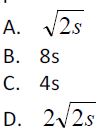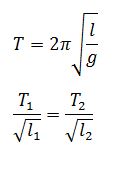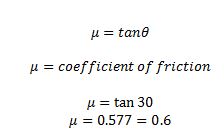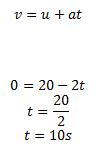How to Solve Some JAMB UTME Physics Past Questions
For all candidates writing JAMB physics, this page provides answers to some UTME physics past questions.
Question 1
Which of the following consists entirely vector quantities? {UTME 2001}
A. Work, pressure and moment B. Velocity, magnetic flux and reaction.
C. Displacement, impulse and power. D. Tension, magnetic flux and mass.
Solution
Vector quantities has both magnitude and direction
Option A – pressure and work are scalar quantities
Option B – they are all vector quantities
Option C- power is a scalar quantity
Option D – mass is a scalar quantity
B is the correct option
Question 2
A plane sound wave of frequency 85.5Hz and velocity 342ms-1 is reflected from a vertical wall. At what distance
from the wall does the wave have an antinode?{UTME 2001}
A. 0. 1m B 1m C. 2m D. 3m
Solution
V =fℷ
ℷ = V/f = 342/85.5 = 4 m
distance to have an antinode = ℷ/4 = 4/4 = 1m
B is the correct option
Question 3
A string is fastened tightly between two walls 24cm apart. The wavelength of the second overtone is{UTME 2001}
A. 12cm B. 24cm C. 8cm D. 16cm
Solution
third harmonic is the second overtone
second overtone = ℷ/2 + ℷ/2 +ℷ/2 = 3ℷ/2
3ℷ/2 = 24
ℷ = 16 cm
D is the correct option
Question 4
Find the frequencies of the first three harmonics of a piano string of length 1.5m, if the velocity of the waves on the
string is 120ms-1.{UTME 2001}
A. 180Hz, 360Hz, 540Hz. B. 360Hz, 180Hz, 90Hz.
C. 40Hz, 80Hz, 120Hz. D. 80Hz, 160Hz, 240Hz.
Solution
first harmonic = F0 = v/2l = 120/2*1.5 = 120/3 = 40Hz
second harmonic = 2f0 = 2*40 = 80Hz
third harmonic = 3f0 = 3*40 = 120Hz
C is the correct option
Question 5
A gas with initial volume 2 x 10-6m3 is allowed to expand to six times its initial volume at constant pressure of
2 x 105Nm-2. The work done is{UTME 2001}
A. 4.0J B. 12.0J C. 2.0J D. 1.2J
Solution
workdone = pdv
dv =V2 – V1 = (6*2 x 10-6) – 2 x 10-6
dv = 12 x 10-6 – 2 x 10-6 = 10 x 10-6
workdone = 2 x 10^5 * 10 x 10-6 = 20 x 10^-1 = 2.0J
C is the correct answer
Question 6
The process of energy production in the sun is{UTME 2001}
A. radioactive decay B. electron collision.
C. Nuclear fission. D. Nuclear fusion
Solution
The answer is Nuclear Fusion
D is the correct option
Question 7
A student is at a height 4m above the ground during a thunderstorm. Given that the potential difference between
the thunderstorm and the ground is 107V, the electric field created by the storm is {JAMB Physics 2001}
A. 2.0 x 106NC-1. B. 4.0 x 107NC-1.
C. 1.0 x 107NC-1. D. 2.5 x 106NC-1
Solution
E = V/d = 10^7 / 4 = 2.5 x 10^6
D is the correct option
Question 8
An object is weighed at different locations on the earth. What will be the right observation? {JAMB Physics 2010}
A. Both the mass and weight vary B. The weight is constant while the mass varies
C. The mass is constant while the weight varies D. Both the mass and weight are constant.
Solution
The mass of an object doesnt change but weight changes because the force of gravity varies from place to place on the surface of earth.There are two reasons behind this variation:
The shape of earth and the rotation of the earth.
C is the correct option
Question 9
In a hydraulic press, the pump piston exerts a pressure of 100 Pa on the liquid. What force is exerted in the second piston of cross-sectional area 3m2?{UTME 2010}
A. 200 N B. 100 N C. 150 N D. 300 N
Solution
Pressure = Force /Area
100 = force/3
force exerted = 300 N
D is the correct answer
Question 10
If the angle between two vectors P and Q is 0 degree, the vectors are said to
A. be perpendicular B. be parallel C. interest at angle 60o. D. intersect at angle 45o. (UTME 2004)
Solution
The angle between two parallel lines is zero, therefore, B is the correct option
Question 11
What happens to the rays in a parallel beam of light?
A. They diverge as they travel. B. They meet at infinity. C. They intersect D. They converge as they travel. (UTME 2004)
Solution
Parallel beam of light meet at infinity
B is the correct option
Question 12
The process whereby a liquid turns spontaneously into vapour is called
A. boiling B. evaporation C. sublimation D. relegation. (UTME 2005)
Solution
Solid to gas is sublimation
liquid to vapour at all temperature is evaporation
liquid to vapour at a fixed temperature is boiling
Since the word spontaneous is used in the question which means occur without having been planned, therefore, evaporation is the best answer.
B is the correct option
Read: Expected topics and questions in JAMB physics
More solutions to JAMB Physics Past questions
Question 1
The energy of a photon having a wavelength of 10^-10m is {utme 2013}
A. 1.7 x 10-12J B. 2.0 x 10-15J C. 1.7 x 10-13J D. 2.0 x 10-12J
Solution
E = hf = hc/λ
h is the planck’s constant = 6.63 × 10–34 J s
c is the speed of light = 3 x10^8
λ is the wavelength
E = (6.63 × 10–34 * 3 x 10^8)/10^-10
E = 19.89 x 10^-16 = 1.989 x 10^-15 = 2 x 10^-15 J
B is the correct answer
Question 2
The bond between silicon and germanium is{utme 2013}
A. ionic B. dative C. covalent D. trivalent
Solution
The bond is covalent. C is the correct option
Question 3
If a current of 2.5A flows through an electrolyte for 3 hours and 1.8g of a substance is deposited, what is the mass of the substance that will be deposited if a current of 4A flows through it for 4.8 hours?{UTME 2013}
A. 4.8g B. 2.4g C. 3.2g D. 4.2g E. 4.6g
Solution
M = ZIt
Z = M / It = 1.8 /2.5*3 = 0.24 g/Ah
Z is electrochemical equivalence and it is a constant
If the current and the time changes
M = 0.24*4*4.8 = 4.6g
E is the correct option
Question 4
An electric device is rated 2000W, 250V. Calculate the maximum current it can take.{utme 2013}
A. 6A B. 9A C. 8A D. 7A
Solution
P = Iv
2000 = 250*I
I = 2000/250
I = 8A
C is the correct option
Question 5
A house has ten 40W and five 100W bulbs. How much will it cost the owner of the house to keep them lit for 10 hours if the cost of a unit is N5?{utme2013}
A. N20 B. N90 C. N50 D. N45
Solution
Total power = 10*40 + 5*100 = 900W =0.9kw
Energy =power x time(hour)= 0.9*10 =9kwh
1kwh = N5
9kwh = N5 *9 = N45
D is the correct answer
Question 6
Calculate the force acting on an electron of charge 1.5 x 10-19C placed in an electric field of intensity 105Vm-1.{utme 2013}
A. 1.5 x 10-14N B. 1.5 x 10-11N C. 1.5 x 10-12N D. 1.5 x 10-13N
Solution
Electric field intensity = force / charge
10^5 = force/1.5 x 10^-19
force = 1.5 x 10^-19 * 10^5 = 1.5 x 10^-14 N
A is the correct option
Solution 7
A man 1.5m tall is standing 3m in front of a pinhole camera whose distance between the hole and the screen is 0.1m.
What is the height of the image of the man on the screen?{utme 2013}
A. 1.00m B. 0.05m C. 0.15m D. 0.30m
Solution
Image distance/object distance = image height/object height
0.1/3 = image height / 1.5
image height = 1.5*0.1 /3 = 0.05 m
B is the correct option
Question 8
Two liquids X and Y having the same mass are supplied with the same quantity of heat. If the temperature rise in X is twice that of Y, the ratio of specific heat capacity of X to that of Y is{utme 2013}
A. 1 : 4 B. 2 : 1 C. 1 : 2 D. 4 : 1
Solution
mxcxQx = mycyQy
mx = my
Qx = 2Qy
cx*2Qy = cyQy
cx/cy = 2/1 = 2:1
B is the correct option
More JAMB Physics Past Questions
All the questions below are UTME past questions
Questions 1 – 5 are from 2013 UTME
Question 1
The resultant of two forces is 50N. If the forces are perpendicular to each other and one of them makes an angle of 300 with the resultant, find its magnitude
A. 25.0N B. 100.0N C. 57.7N D. 43.3N
Solution
since the two forces are perpendicular, it can be represented using a right-angle triangle. Also one of the make an angle 30 degree with the resultant.
Using SOHCAHTOA
the resultant is the hypothenus
cos θ = adj / hyp
cos 30 = x / 50
0.866 * 50 = x
x = 43.3 N
D is the correct option
Question 2
A simple pendulum of length 0.4m has a period 2s. What is the period of a similar pendulum of length 0.8m at the same place?

Solution


cross multiply
![]()
D is the correct option
Question 3
An object is moving with a velocity of 5ms-1. At what height must a similar body be situated to have a potential energy equal in value with the kinetic energy of the moving body?
A. 1.0m B. 25.0m C. 20.0m D. 1.3m
[g ≈ 10ms-2]
Solution
K.E = Mgh
1/2 mv^2 = mgh
1/2 * m * 5^2 = m * 10* h
25 / 2 =10h
h = 25 / 20
h = 1.25 m, approximately = 1.3 m
D is the correct option
Question 4
If a sonometer has a fundamental frequency of 450Hz, what is the frequency of the fifth overtone?
A. 75Hz B. 2700Hz C. 456Hz D. 444Hz
Solution for a sonometer box
first overtone = 2f0
second overtone = 3f0
third overtone = 4fo
fourth overtone = 5f0
fifth overtone = 6f0
therefore,
fifth overtone = 6 * 450 = 2700 Hz
B is the correct option
Question 5
An electric device is rated 2000W, 250V. Calculate the maximum current it can take.
A. 6A B. 9A C. 8A D. 7A
solution
p = Iv
2000 = 250I
I = 2000 / 250
I = 8 A
C is the correct option
Question 6-8 are from 2012 UTME
QUESTION 6
Calculate the total distance covered by a train before coming to rest if its initial speed is 30ms-1 with a constant retardation of 0.1ms-2.
A. 5500m B. 4500m C. 4200m D. 3000m
Solution
v2 = u2 + 2as
since the car is decelerating, the acceleration = – 0.1 ms-2
0 = 30^2 – 2 * -0.1 * s
0 = 900 – 0.2s
900 = 0.2 s
s = 900 / 0.2
s = 4500 m
B is the correct option
Question 7
An object moves in a circular path of radius 0.5m with a speed of 1ms-1. What is its angular velocity?
A. 8 rads-1 B. 4 rads-1 C. 2 rads-1 D. 1 rads-1
Solution
![]()
1 = ω * 0.5
ω = 1 / 0.5
ω = 2 rads-1
C is the correct option
Question 8
An object of mass 20kg slides down an inclined plane at an angle of 30o to the horizontal. The coefficient of static friction is
A. 0.2 B. 0.3 C. 0.5 D. 0.6
[g = 10ms-2]
Solution
mgsinθ – µR = 0
µ = mgsinθ / R
R = mg
µ = mgsinθ / mg
µ = sinθ
µ = sin 30 = 0.5
C is the correct option
Question 9
The equation of a wave travelling in a horizontal direction is expressed as y=15 sin (60t-πx) what is its
wavelength?
A. 60m B. 15m C. 5m D. 2m
Solution
y = A sin (ωt – ∅)
∅ = 2π /⋋
π = 2π / ⋋
⋋ = 2π / π
⋋ = 2 m
Question 10
Three similar cells each of e.m.f 2V and internal resistance 2Ω are connected in parallel, the total e.m.f and total internal resistance are respectively { UTME 2011}
A. 6 V, 0.7Ω B. 6 V, 6.0Ω C. 2 V, 0.7Ω D. 2 V, 6.0Ω
Solution
Since the cells are arranged in parallel
the e.m.f will be 2v
1/r = 1/r1 + 1/r2 + 1/r3
1/r = 1/2 + 1/2 + 1/2
1/r = 3/2
r = 2/3
r = 0.7Ω
C is the correct option
Answers to JAMB Physics Questions
Question 1
A bullet fired vertically upward from a gun held 2.0m above the ground reaches its maximum height in 4.0 s. calculate its initial velocity. {2009}
A.10ms-1 B.8ms-1 C. 40ms-1 D. 20ms-1
[g = 10ms-2]
Solution

C is the correct option
Question 2
An object of mass 80kg is pulled on a horizontal rough ground by a force of 500N. Find the coefficient of static friction. {2009}
A.0.8 B. 0.4 C. 1.0 D. 0.6
[g = 10ms-2]
Solution

D is the correct option
Question 3
Two cars moving in the same direction have speeds of 100kmh-1 and 130kmh-1. What is the velocity of the faster car as measured by an observer in the slower car? {2010}
A.130kmh-1 B. 230kmh-1 C. 200kmh-1 D. 30kmh-1
Solution
You are to calculate the relative speed
![]()
D is the correct option
Question 4
A car moves with an initial velocity of 25ms-1 and reaches a velocity of 45ms-1 in 10s. What is the acceleration of the car?{2010}
- 5ms-1 B. 25ms-1 C. 20ms-1 D. 2ms-1
Solution

D is the correct option
Question 5
Two balls X and Y weighing 5g and 50kg respectively were thrown up vertically at the same time with a velocity of 100ms-1. How will their positions be one second later? {2011}
A. X and Y will both be 500m from the point of throw
B. X and Y will be 500m from each other
C. Y will be 500 m ahead of X
D. X will be 500m ahead of Y.
Solution
The distance covered after one second

S = 500m
The position the two balls will be from the point of throw is independent on their mass.
A is the correct option
Question 6
If it takes an object 3s to fall freely to the ground from a certain height, what is the distance covered by the object?
A. 60 m B. 90 m C. 30 m D. 45 m.
[g = 10ms-2]
Solution
Initial velocity = 0

S = 45m
D is the correct option
Question 7
Calculate the total distance covered by a train before coming to rest if its initial speed is 30ms-1 with a constant retardation of 0.1ms-2. {2012}
A. 5500m
B. 4500m
C. 4200m
D. 3000m.
Solution
V = 0
U =30ms-1
a=-0.1ms-2
The a is negative because the motion is retarding i.e. deceleration

S = 4500 m
B is the correct option
Question 8
A car starts from rest and moves with a uniform acceleration of 30ms-2 for 20s. Calculate the distance covered at the end of the motion.{2012}
A. 6km
B. 12km
C. 18km
D. 24km.
Solution

S = 6000m = 6km
A is the correct option
Question 9
An object of mass 20kg slides down an inclined plane at an angle of 30o to the horizontal. The coefficient of static friction is {2012}
A. 0.2 B. 0.3 C. 0.5 D. 0.6
[g = 10ms-2]
Solution

D is the correct answer
Question 10
A train with an initial velocity of 20ms-1 is subjected to a uniform deceleration of 2ms-2. The time required to bring the train to a complete halt is
- 40s B. 5s C. 10s D. 20s
Solution
V = 0
U = 20
a= -2

C is the correct option
Question 11
Calculate the apparent weight loss of a man weighing 70kg in an elevator moving downwards with an acceleration of 1.5ms-2. {2013}
A. 105N B. 686N C. 595N D. 581N
Solution
The apparent weight loss = ma = 70 * 1.5 = 105N
A is the correct option
Question 12
The coefficient of friction between two perfectly smooth surface is {2013}
A. Zero B. Infinity C. One D. Half
Solution
A is the correct option
Recommended:
